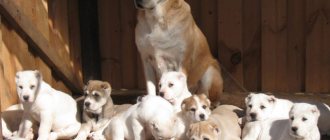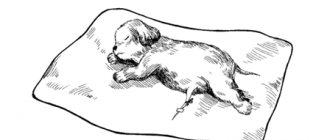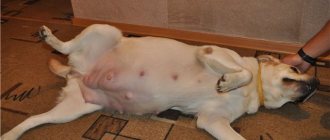04/13/2019 Drozd Nikolaevich Animals 3 Estrus in a dog is a process that indicates that the female has entered puberty. Scientifically, the phenomenon is called estrus. It is believed that if it has begun, it means the dog is ready to mate and bear offspring. When this happens, how long it lasts and with what frequency it happens, we will consider further in detail.
What are medium breeds?
Before answering the question of how long estrus lasts in dogs of medium breeds, it is worth understanding which specific animals belong to the group in question. But there are a lot of them - more than 200 species. At the same time, pets of this size are considered the most popular among breeders. So, medium breeds include dogs whose height at the withers is 40-50 cm. Their weight is 12-40 kg.
Dogs belonging to medium breeds can live comfortably in apartments; they can easily fit in an elevator. They are, as a rule, non-aggressive, love children, and are capable of becoming excellent guards. It is important for the owner of the animal to know how many days the dog is in heat in order to behave correctly during this time.
A little physiology
When a dog reaches puberty, eggs mature in its ovaries. Sexual cycles are outlined that will continue throughout the animal’s life. The period of puberty is marked by the fact that a serious restructuring occurs in the body. Under the influence of hormones, the reproductive system and mammary glands develop. Puberty occurs before the growth and development of the body ends. Therefore, it is important to understand that the onset of this period does not mean that the dog is ready to reproduce.
The estrous cycle (estrus) in a dog, as a rule, begins when the female’s weight has reached 2/3 of the weight of an adult. In medium breed dogs this period ranges from 8 to 12 months. Its onset is influenced by many factors: living conditions, feeding.
During the first heats, the female's birth canal is not yet fully developed, so the onset of ovulation does not mean that the dog is able to bear and give birth to puppies. The physiological maturity of the female will come later, around the third, fourth, and sometimes fifth estrus.
Most countries legally establish the age of a dog when the first mating can be allowed. Unfortunately, this does not exist in Russia yet. Therefore, it is worth listening to the advice of experienced dog breeders.
When does the first heat occur?
In dogs of medium breeds, estrus begins in the age period from 7 months to 1.5 years. It can be noticed by the onset of heavy molting. The first heat is usually the shortest in duration. It may be mild, with a small amount of blood. It usually begins after the dog's teeth have changed.
False estrus also occurs. It is possible in dogs close to puberty. If mating is allowed during it, estrus may be interrupted without ovulation occurring. However, after a few days, estrus may resume, the discharge will become abundant, which will attract male dogs.
How long does a dog's heat last and how often?
Photo from flywall.ru
When we mean the first estrus, then, as mentioned above, it is shorter than the others, usually 3-5 days.
There are many factors that determine the duration of estrus:
- Accommodations.
- Diet.
- Age.
- Breed.
- Environment and more.
You can understand how many days the dog will be in heat and how often it will happen only by keeping your own records of the days when the blood flows. If we look at statistics, we will see that on average estrus lasts 20 days. Please note that the cycle finally normalizes over time, around two years. If you want to know exact dates, make accurate and thorough calculations and observations that will help you with this.
Typically, domestic dogs have mating season once or twice a year. The interval between estrus is approximately 6 months. The estrus itself lasts about 20-25 days. At first, the female will be aggressive, because her body is not yet ready for reproduction, but on the tenth day she herself will show a desire to mate.
It often happens that menstruation is affected by the age and breed of the animal. For example, estrus in a husky occurs only once a year. Older pets may have no external signs of estrus at all, but if mating is allowed to occur, pregnancy may occur. Also, changes in the cycle may be a consequence of hormonal imbalance in the dog. For example, having become infected with anostria, the female’s body will secrete too few hormones, and estrus will not occur.
Signs manifested in behavior
When the first heat in dogs (medium breeds and any other) begins, the owner may notice the following changes in his pet:
- urination becomes more frequent;
- behavior changes - the dog may become restless or, on the contrary, depressed;
- drooling is occasionally observed;
- pupils dilate;
- the animal’s orientation in space is disrupted;
- Male representatives among dogs may show interest in the female;
- bloody discharge appears from the so-called loop;
- wool falls out.
How soon does estrus occur after giving birth?
Photo from the site tapetynapulpit24.pl
Often owners calm down when the female gets puppies. The appearance of cubs and feeding them with milk does not at all mean that estrus will not occur again after pregnancy. According to average statistics, menstruation can begin again within a couple of months after giving birth. Typically, the longest interval between birth and new heat is 6–7 months. Signs of renewed sexual activity will be the same as before.
However, new estrus does not mean that the animal is ready to breed. Most owners try to avoid unwanted pregnancy for as long as possible, because it can harm the health of a dog that has not yet recovered from pregnancy and nursing.
The duration of menstruation in furry pets does not change and remains at the level of nulliparous dogs. In general, changes in the pet’s behavior and bloody discharge from the loop are observed for about 25 days. When the same reddish discharge appears in the female during postpartum estrus, 9 days must be counted from this day. This number will be the beginning of ovulation, which lasts about 7–10 days.
The number of days in postpartum menstruation should not increase. Typically, estrus in dogs that occurs more than 3 times a year indicates serious disturbances in the functioning of the reproductive system and shifts in the hormonal balance.
Periods of heat
The reproductive cycle consists of several parts:
- Proestrus lasts from 7 to 10 days. The body is preparing for ovulation. The vulva swells, the genitals are hyperemic. As a result of rupture of blood vessels in the uterus, spotting begins, by the end of the period it becomes lighter and less abundant. At this time, you can notice how the dog's behavior changes. She is excited, active and playful. During a walk, it can mark territory, disobey the owner and show interest in the opposite sex. However, the dog does not allow the male yet.
- Estrus. This is the period of ovulation, lasting on average 9 days. The discharge has become light in color and can sometimes be bloody. The swelling of the genital organs subsides. The female allows the male to approach her and withdraws her tail. All other reflexes are muffled, the dog may not feel hungry.
- Metaestrus (diestrus) - lasts several days, the bleeding stops, the female does not allow dogs of the opposite sex to approach her. The end of the heat is coming.
- Anestrus is a period of sexual rest, its duration can reach 150 days.
Physiological processes in a dog’s body take place under the influence of estrogen hormones. They affect the animal’s reproductive system, creating conditions for the appearance of estrus: swelling of the genital organs appears, the epithelium of the uterus is rejected, hyperemia of the vulva appears, and the membranes of the dog’s reproductive organs swell.
During the described period, the mammary glands may enlarge, and secretions come out of them. This sometimes leads to mastitis and even tumors. In such cases, veterinarians recommend sterilizing the dog.
Do dogs go into heat after sterilization?
Sometimes, during sterilization, the veterinarian only ties the fallopian tubes, in which case the entire estrus will be in the same volume. This means that after the operation you will have menstruation, but you will not be able to get pregnant.
When surgery is performed to remove the ovaries and uterus, estrus no longer occurs. However, it happened that after castration the adrenal glands took over the work of the ovaries. In such a situation, menstruation began again.
Basically, they castrate those females that were found to be unsuitable for breeding or the owner simply does not want to breed puppies. Diseases of the genital organs, inflammation and tumors of the mammary glands and other medical conditions can also cause sterilization.
Duration and frequency
How many times a year can a female go into estrus? What will be the duration of a dog's estrus (medium breeds and all others)? Undoubtedly, these questions concern every owner of a four-legged pet.
Estrus usually occurs twice a year or three times every 14 months. It’s bad if the cycle is more than 8 months and less than 4. This may indicate a dog illness or a hormonal disorder. Then you cannot do without contacting a veterinarian.
The cycle is established by the age of 2 years. Until the pet has reached this milestone, there may be different periods between heats, and this is the norm, there is no need to worry. In adulthood, the cycle is smooth, but deviations of several weeks are allowed.
Since the frequency of estrus in medium breed dogs is not exactly a month, its onset dates shift throughout the year. Therefore, it is important for the owner to record the start and end dates of this period.
The duration of estrus can depend on many factors. It is impossible to give a definite answer to the question of how long estrus lasts in medium breed dogs. This may depend on the conditions of detention. If the dog lives side by side with members of the opposite sex, the duration of estrus may increase. If the pet leads an active life, participates in training and training, and is loaded with physical exercises, the period ends earlier.
How long the estrus lasts in medium breed dogs also depends on the season. In winter, estrus ends earlier, and in summer it can last longer. Although this rule does not often apply to domestic dogs. But if the pet lives in an enclosure, this may be relevant for her.
The duration of estrus can also be affected by the dog’s well-being and health. If she has chronic illnesses, this will have a direct impact on the duration of estrus.
The question of how often estrus occurs in medium breed dogs is individual for each female. If the dog is old, the cycle increases in duration, the “resting phase” also stretches out more and more every year. At the same time, estrus does not stop even in dogs of a “respectable” age. Young pets have a longer cycle. It is important for the owner to record all changes: the beginning of estrus, the end, the behavior of the animal. This information can help track various dog health problems.
Sexual cycle in dogs
» Biovetlab.ru » Publications » Reproductive cycle in dogsFishing online store
There is a division of animals based on the rhythm of the sexual cycle into mono- and polycyclic. The first group includes animals with 1 sexual cycle per year. In polycyclic animals, several cycles occur, which are repeated with a certain frequency during the season or the whole year, depending on the type of animal. It is difficult to classify dogs into any particular of these groups, since they can have 1-2 or even 3 sexual cycles throughout the year. Therefore, some authors classify dogs as monocyclic, while others consider them dicyclic animals.
A number of signs prevail that indicate that dogs should be classified as monocyclic animals. For example, representatives of wildlife from the canine family (wild dogs Dingoes, wolves, jackals, coyotes) have only one sexual cycle per year and at a strictly defined time of year. And domestic dogs have a lot in common with them and can be crossed. In addition, females experience estrus after the aestrous period, which is also typical for monocyclic animals. The increase in the number of cycles in dogs and their independence from the seasons arose during the process of their domestication.
As a rule, the period of sexual activity of females is determined by the interestrous period. The fact is that establishing the duration of the reproductive cycle of dogs and the time of its completion is possible only with the use of laboratory research methods. To do this, the dynamics of the hormone progesterone in the blood and the nature of vaginal smears are analyzed. The duration of the interestrous period can be different and varies depending on the breed.
The duration of the interestrous period does not depend on pregnancy. The reproductive cycle of dogs is special and differs significantly from the cycle of other domestic and farm animals. Before the start of sexual heat, bitches develop hemorrhagic discharge resulting from diapedesis. When sexual heat occurs, an immature egg ovulates, which can be fertilized 2-3 days from the moment it enters the oviduct. By the end of sexual heat, an active corpus luteum is formed. Unlike dogs, in other animals the corpus luteum is formed at the end or after sexual heat, and a separate stage of the cycle is distinguished - metestrus (inhibition period). This is followed by a period of sexual rest - anestrus.
Thus, the reproductive cycle of dogs is divided into 4 phases, or stages:
- proestrus;
- estrus;
- diestrus;
- anestrus.
Let us consider each of these stages in more detail.
Proestrus ( precursor)
.
The duration of this phase is approximately 9 days. Its signs are bloody vaginal discharge and swelling of the vulva. Depending on the breed, the intensity of the discharge varies; it may not be noticeable at all if the dog licks it. Urination becomes more frequent. Towards the end of the phase, the bitch begins to attract males, but does not allow intercourse. At the same time, there is a small probability of ovulation, and a few days later - fertilization.
Estrus
Estrus, like pre-gestation, lasts approximately 9 days. During this period, the vulva becomes softer. The first sign of the onset of the phase is the individual’s readiness for intercourse. At the same time, the discharge becomes thinner and less abundant. This is typical only for those bitches who experienced intense discharge during the proestrus phase. As already mentioned, depending on the breed, dark-colored discharge may be slight and continue during the first three periods of the sexual cycle. Ovulation occurs either at the very beginning of estrus, or on days 2-4.
Metestrus
(diestrus)
The duration of diestrus is 60 days. The phase begins from the moment when the individual first rejected coitus. Swelling of the vulva gradually disappears, bleeding stops. Mucus discharge may appear.
Anestrus
The phase is characterized by a period of ovarian rest and continues until the beginning of the next proestrus. It is difficult to accurately determine the duration of anestrus, since it depends on the time of year, and on provocation by pheromones, when a female in heat is nearby, feeding conditions, housing and other factors. The stability of the intervals of the sexual cycle is maintained for 6 years, and then the duration of anestrus and the time interval between estrus increases.
Vaginal cytology
In proestrus, there is first an increase in the concentration of estradiol, which promotes cell division in the basal layers of the vaginal epithelium. Next, the concentration of this hormone decreases, and more dead cells are traced in the sample taken. As proestrus progresses, the number of epithelial cells containing the nucleus decreases. The smears reveal an increased concentration of red blood cells (up to the middle of proestrus). The peak formation of keratinized cells occurs along with an increase in the amount of the hormone progesterone, indicating the beginning of the fertile period.
Due to its simplicity and accessibility, this method remains the most popular for determining the reproductive status of a dog. The material for the study is taken using a long plastic or wooden stick with a cotton swab at the end, which is inserted deep into the vagina and a smear is taken. When collecting a sample, it is important to prevent the swab from coming into contact with the external genitalia, since the cells that enter will blur the cytological picture.
The resulting cells are placed on glass and then stained. There are two most popular methods. In the first case, the dead cells acquire an orange tint, and the active (containing nuclei), basal and parabasal epithelial cells become blue or green. In the second, the cells are stained in different colors of blue and blue, and the morphology of the cells is assessed.
By the end of estrus, spotting changes significantly. The nature of the changes is accompanied by the appearance of epithelial cells with poison and an increase in the number of leukocytes. These phenomena are observed 7-9 days after the LH peak and are designated “vaginal metestrus smear.”
It should be noted that vaginal cytology is a fairly informative method for establishing the phase of the estrous cycle. The use of the technique is limited due to significant time differences in the manifestation of the main signs of estrus and peak fertility.
Changes in the color intensity of vulvar discharge during estrus.
Start of heat end of heat
Anestrus Proestrus
Estrus Diestrus
Quantitative determination of progesterone (ovulation monitoring)
The concentration of progesterone in the blood begins to increase approximately 5 days before the onset of ovulation and exceeds the baseline concentration level by 3-6 or more times. Depending on the breed, the level of increase in concentration and growth rate will differ. Laboratory studies have found that during ovulation, the level of this hormone reaches an average of 5-10 ng/ml.
It is believed that artificial insemination or mating should be carried out within the next 48 hours from the onset of ovulation. In this case, the time of maturation of germ cells in bitches should be taken into account (2-3 days). Control mating is carried out 2 days after the first.
Accurate calculation of the moment and time of ovulation helps to increase the number of successful matings and the fertility of the female. A small litter, often attributed to the age of the dog, is most often caused by the wrong choice of moment for mating.
The simultaneous implementation of vaginal cytology and determination of progesterone concentration allows for a fairly complete and accurate observation of all stages of estrus and assists in increasing the number of puppies in the litter.
Pg: basal (
• ovulation has not yet begun;
• wait 3 or 5 days.
Pg: slight increase (1 - 3 ng/ml):
• ovulation will occur soon;
• next blood draw in 1 - 2 days.
Pg: reaches a value of 5 - 10 ng/ml: ovulation has occurred. Mating is possible in 1-2 days.
Veterinarian
Maria A. M.
RELATED PUBLICATIONS
Free fluid in the chest and abdomen
The appearance of free fluid in the abdominal or thoracic cavity often indicates serious disturbances in the functioning of the internal organs of our patients and hemodynamic changes. In all cases of detection of free fluid, it is necessary to carry out a diagnosis as quickly as possible. It is necessary to determine the reasons that provoked the formation and accumulation of fluid in the abdominal or thoracic cavity. In addition, when severe symptoms of compression of internal organs develop, this fluid must be removed from the cavities.
Diarrhea in cats and dogs
Diarrhea in animals is a symptom that occurs in many diseases. Possible causes of intestinal dysfunction may be poisoning, infections, liver and pancreas diseases, dysbacteriosis, neoplasms and other diseases accompanied by severe intoxication. Also, diarrhea in cats and dogs can be a consequence of an incorrectly selected diet, a sudden change in food, or eating garbage and spoiled food.
THIS IS INTERESTING:
Recommendations for the owner
So, how long does estrus last in dogs of medium breeds is now clear, but how should the owner behave during this period? If estrus is the first, the owner should write down all the data about the beginning and end of the period, as well as the behavior of the pet at this time. This information will help calculate the time until the next heat, as well as indicate a favorable mating period.
If the owner does not plan to breed offspring, the best thing during this period is not to let the dog off the leash. This applies even to docile animals. During sexual activity, the dog may become uncontrollable and lose control. And it will be extremely difficult to pull the male away from her.
Also, you should not participate in exhibitions. Firstly, your pet’s behavior changes and can sometimes become unpredictable. And secondly, accidental mating cannot be ruled out.
During estrus, it is important to protect your dog from possible infections. For example, you should not allow her to swim in a pond.
Main questions
Below, we provide you with answers to the most common questions about estrus in dogs.
How long does a dog's heat last?
There are plenty of nuances that affect the duration of a dog’s estrus:
- conditions of detention;
- nutrition;
- age;
- breed, etc.
In fact, you can find out how long your dog’s heat will last only by taking into account personal experience and observations. If we take the average number, it is 20 days.
Keep in mind that the dog’s final estrus cycle is not established immediately; everything stabilizes only by the age of two. If you want to know exactly what, how much and why, make observations and write down the results.
If we talk about a dog’s first heat, then, as already mentioned, it does not last long. On average, the entire cycle is 3-5 days.
How often do dogs go into heat?
On average, ornamental breeds go through the heat period 2 times a year. This condition lasts 20-25 days. The interval between heats is approximately 6 months.
Important! The frequency of estrus in female dogs depends on age, breed (size of the dog) and health status.
For example, the Laika breeds only once a year. If the dog is old, then there may be no external signs of estrus at all, but if she is allowed to mate, she will become pregnant. Also, the cycle may be disrupted due to hormonal imbalances in the animal’s body. For example, if a dog has anostria, then the pet’s body produces few hormones and such a dog will not go into heat.
When does a dog go into heat after giving birth?
To find out how long it will take for dogs to go into heat after giving birth, you need to consider the size of the animal and the breed. As a rule, small dogs breed once every six months, and large breed animals breed less often - once every 8-12 months. In general, it is impossible to assign exact figures about the frequency and duration of estrus. Here everything depends on each specific case: breed, size, etc. To find out exactly when the first heat will be after giving birth, the owner must monitor the pet and control its cycles.
The main thing you need to understand is that in prevailing cases, estrus after childbirth will occur when the time of the cycle comes and the animal’s pregnancy does not affect this. That is, the birth of estrus is not delayed.
Does estrus stop in dogs after mating?
The intensity of a dog's estrus after mating decreases and rarely stops. Everything is going as usual. In this regard, it is necessary to control the dog until its sexual desire completely ends. And even if during the mating period your pet behaved kindly towards the future father of the puppies, this does not mean that she will not want to take a walk somewhere on the side.
Dog smell
The unpleasant smell of a dog during heat, as well as its intensity, depend on the individual characteristics of the pet.
One bitch may generally smell during the period of heat, another will “smell” during the second cycle, and an unpleasant odor from a third will haunt the owners almost constantly. Of course, we are talking about the smell that people smell; for a male dog, a dog in heat always smells.
If you visit a pet store, you can find a lot of different products that fight off the unpleasant odor of a bitch. Popular products include the following sprays:
- Jimpet.
- Beafar.
- 8in1.
These products belong to the luxury category, and if you want something cheaper, then you can consider such options as: Smart spray, Anticobelin, etc.
Important! It is worth considering that the smell may not be associated with estrus, but act as a signal about the presence of hormonal disorders in the dog’s body.
It also happens that a dog is absolutely healthy, and an unpleasant odor during estrus is its individual characteristic. But in any case, if there is any suspicion about the nature of the “aromas”, it is better to show your pet to a veterinarian.
Hygiene rules
Dog owners often wonder: should their pet wear special underpants during estrus? There are pros and cons to wearing them.
Veterinarians do not recommend using such a hygienic device during estrus, since the dog must lick itself.
But sometimes such panties are simply necessary: for example, a pet is used to sleeping on a bed or she has to travel on public transport. In the second case, you should take care to protect the dog from infections.
When choosing hygiene panties for your dog, you should evaluate the material from which they are made. It must be natural. A hole is necessary for the tail, and seams are undesirable so that the animal's skin is not irritated. This item must be chosen in size so that the dog feels comfortable. There are options with Velcro and fasteners. There are even overalls.
Owners who want to save money make such products themselves from children's rompers or shorts.
Possible problems
Some owners, not knowing how estrus occurs in medium breed dogs, do not notice its onset. Especially if it’s the first and it’s bloodless. All signs of estrus may be present except blood. It also happens that there are no signs of estrus, but it passes.
In such a situation, the owner should be careful. After all, males do not allow a dog in heat to pass through, and mating can occur and, as a consequence, conception.
To determine whether the female is in bloodless estrus, tests are performed. It is absolutely necessary to contact a veterinarian with your dog, because estrus without blood is an abnormal phenomenon. The specialist will be able to determine the hormonal background of the animal and, if necessary, prescribe treatment. You should not miss an unusual heat, because it may indicate the presence of tumors or other diseases.
Mating planning
If the owner knows how many days it takes for dogs of medium breeds to go into heat, he will be able to prepare the pet for mating if he plans to get offspring from her. The notes made earlier will help in this matter. Thanks to them, you can understand how many days must pass from the onset of estrus before the dog can be sent for mating. It is very important to determine the moment of ovulation; it usually occurs 11-15 days after the start of estrus.
Mating should be carried out before feeding the dogs. The female is brought to the male, and not vice versa. The atmosphere should be calm, crowds of people are undesirable. Usually dogs are able to figure out such matters on their own. In rare cases, the assistance of a knitting instructor is required.










